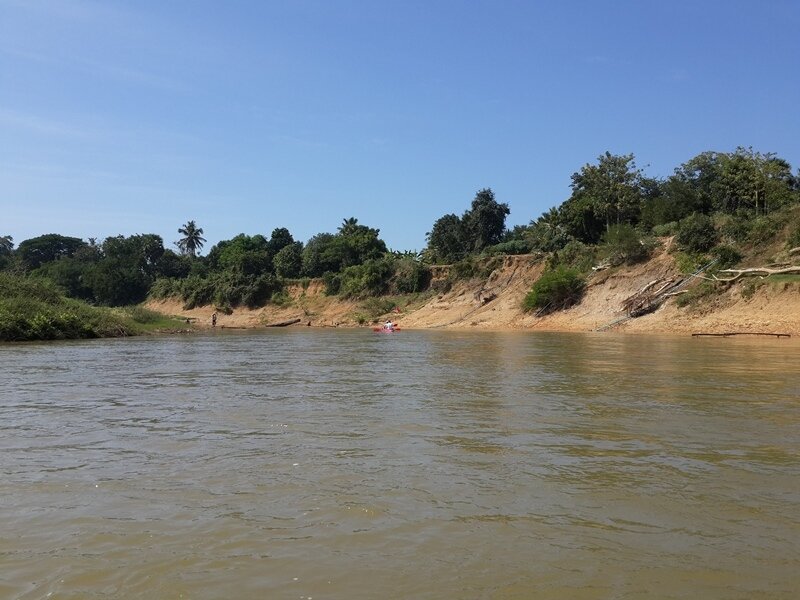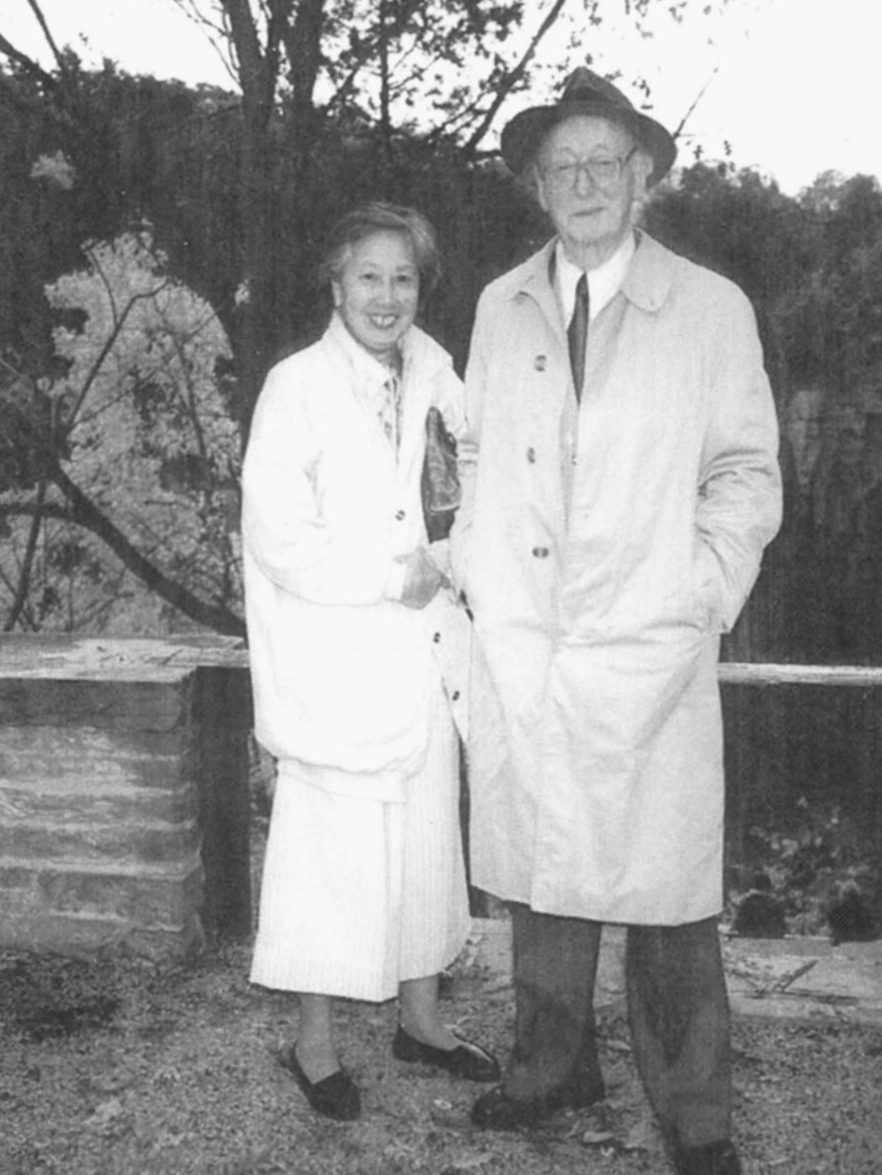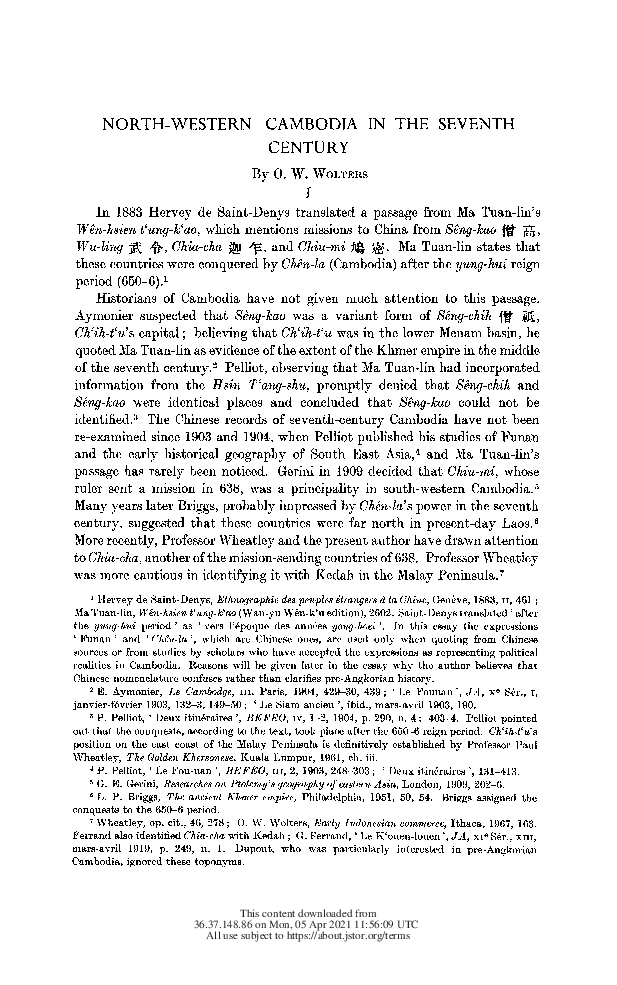North-Western Cambodia in the Seventh Century
by O. W. Wolters
Reconstructing the geographical and political entities in the "Chenla of the Land" and "Chenla of the Water" areas during pre-Angkorean times.

Publication: BSOAS (Bulletin of the School of Oriental and African Studies), University of London, Vol. 37, No. 2 (1974), pp. 355-384
Published: 1974
Author: O. W. Wolters
Pages: 30
Language : English
pdf 4.2 MB
Before Chenla, as an entity, overcame the Funan rulers, there were several principalities or´visaya´(provinces) in the north-western area of modern Cambodia. Studying Chinese official and historiographical sources such as In Ma Tuan-lin’s Wen-hsien-t’ung-k’ao, or the Ts’e-fu yuan-kuei (TFYK), the author vividly describe their interactions and their contacts with the outer world, in particular with Khmer and Chinese missions going back and forth.
According to this study, “in Angkorian times the northern contained at least three provinces: the Dangreks province, Sangkhah, and Amoghapura. The first of these was at the foot of the mountains. Sangkhah included at least the territory between Kralanh and the site of the Phnom Net Prah inscription between the river Sreng and the neighbourhood O Ta Siu river, which flows into the river system from the north. To the of Sangkhah between the Dangreks and Gajapura lay some, if not all, territory of Amoghapura province.”
Further on, he remarks that Cambodia ‘was still studded with local chieftainships, whose rulers by no means felt that they already normally belonged to a larger and permanent political unity. Ambitious chiefs would emerge from time to time, but the path to overlordship was never an easy one. Only Jayavarman I stands out as a person who could hold together a large territory for a considerable length of time, and even his achievement did not survive him. The chiefs in north- western Cambodia were not the only ones who exploited the vacuum caused by the decline of an overlordship in order to resume what they regarded as a normal state of independence. In this situation the term ‘kingdom ’ as some- thing distinct from the temporary territorial influence of a successful soldier- chief is an inappropriate one. Greater unities were still only the fragile con- sequence of the prowess of an individual leader. This kind of unity quickly dissolved when an overlord died or lost the confidence of his allies.’
Photo: The Sangke River, Northwestern Cambodia (by Samlout Sangke River Trail)
Tags: Chenla, Funan, Jayavarman I, Jayavarman II, Chinese missions, Chinese sources
About the Author

O. W. Wolters
Oliver William Wolters (8 June 1915, Reading, UK – 5 December 2000, Ithaca, N.Y., USA) was a British academic, historian and author who did pioneering work on the ancient Malay kingdom of Srivijaya — following the exploratory studies by George Coedès — and Southeast Asia ancient history.
Wolters was a British-administrated Malay States civil servant and administrator for near twenty years (1938−1957), being imprisoned in 1942 by the Japanese occupying forces for three and a half years in Changi prison, Singapore, where he was studying Cantonese. He came late to academic life, lecturing at London School of African and Oriental Studies (SOAS) in London from 1957 to 1963, then moving to Cornell University (Ithaca, USA), where he was the chairman of the department of Asian studies from 1970 to 1972, chair he kept after his retirement in 1984. At his death, he was the Goldwin Smith Professor of Southeast Asian History Emeritus at Cornell University.
Wolters authored many essays on Southeast Asia regional history, including “The Khmer King at Basan (1371−1373) and the Restoration of the Cambodian Chronology during the 14th and 15th Centuries” (1965). On Srivijaya, the maritime and commercial kingdom that flourished from the 7th to the 13th centuries in the Malay Archipelago (centered on Palembang on the island of Sumatra), he published ”Early Indonesian Studies and the Origins of Srivijaya” in 1967. In 1970, he published ”The Fall of Srivijaya in Malay History”. At the same time, he expanded his vision of Southeast Asia, pioneering the approach of local cultures prior to “Indianization” and revisiting Chinese sources on the region. (“localization”).

Publications
- ‘Emergency Resettlement and Community Development in Malaya’, Perak, Community Development Bulletin, 3(1), 1951.
- “Śrīvijayan Expansion in the Seventh Century”, Artibus Asiae (ArA), Vol. 24, No. 3⁄4,1961, pp. 417 – 424
- Early Indonesian Commerce: a Study of the Origins of Srĭvijaya, 1962.
- The Khmer King at Basan (1371−1373) and the Restoration of the Cambodian Chronology during the 14th and 15th Centuries,1965.
- Some Reflections on the Subject of Ayudhyā and the World, 1967.
- The Fall of Śrīvijaya in Malay History, Kuala Lumpur, Oxford University Press | London, Lund Humphries Publishers, 1970, 274 p.
- Early Indonesian Commerce: A Study of the Origins of Srivijaya, Ithaca, Cornell University Press, 1967 [doctoral thesis dedicated to D.G.E. Hall] ; 2nd ed. 1974.
- [ed. with C.D. Cowan] Southeast Asian History and Historiography: Essays Presented to D.G.E. Hall, Cornell University Press, 1976, 236 p.
- “Studying Srivijaya”, Journal of the Malaysian Branch of the Royal Asiatic Society (JMBRAS), 52 – 2, 1979.
- “Assertions of Cultural Well-Being in Fourteenth Century Vietnam: Part two”, Journal of Southeast Asian Studies 11, no. 1, 1980, p 74 – 90.
- History, Culture and Region in Southeast Asian Perspectives, London, Ashgate Pub Co, 1982; revised ed. Singapore, Southeast Asia Program Publication, 1999, 275 p.
- “Phạm [unrepresentable symbol] Mạnh’s Poems Written while Patrolling the Vietnamese Northern Border in the Middle of the Fourteenth Century”, Journal of Southeast Asian Studies, Vol. 13, No. 1, 1982, pp. 107 – 119.
- ‘Restudying Some Chinese Writings on Sriwijaya’, Indonesia, 42, 1986.
- Two essays on Đại-Việt in the Fourteenth Century, New York, Yale University Southeast Asia Studies, 1988, 480 p.
- Perdagangan awal Indonesia: satu kajian asal usul kerajaan Srivijaya, Djarkarta, ACLS Books, 1989.
- “Southeast Asia as a Southeast Asian Field of Study”, Indonesia 58, Oct. 1994, p 1 – 7.
- “Chu Van An: An Exemplary Retirement”, The Vietnam Review, 1996, pp. 62 – 85.
- Early Southeast Asia: Selected Essays (Studies on Southeast Asia), Ithaca, Cornell University Southeast Asia Program Publications, 2007 [ed. Craig Reynolds, in memory of O.W. Wolters].
- Monologue, Dialogue, and Tran Vietnam, Cornell University Press [manuscript comprised of materials completed by O. W. Wolters before his death], 2009.

